Animal Kingdom 1000+ MCQ with answer for RBI Assistant
Thursday 9th of March 2023

Sharing is caring
1. Which of the following class is being correctly described by given statements (i - iv)?
(i) All living members of this class are ectoparasites on some fishes.
(ii) They have a sucking and circular mouth without jaws.
(iii) Circulation is of closed type.
(iv) They are marine but migrate for spawning to fresh water. After spawing, within a few days they die.
A. Cyclostomata
B. Chondrichthyes
C. Osteichthyes
D. Amphibia
Answer : A
(i) All living members of this class are ectoparasites on some fishes.
(ii) They have a sucking and circular mouth without jaws.
(iii) Circulation is of closed type.
(iv) They are marine but migrate for spawning to fresh water. After spawing, within a few days they die.
A. Cyclostomata
B. Chondrichthyes
C. Osteichthyes
D. Amphibia
Answer : A
2. Which of the following phylum is being described by the given statements?
(i) They are bilaterally symmetrical,triploblastic, segmented and coelomate animals.
(ii) The body consists of head, thorax, abdomen and have jointed appendages.
(iii) Circulatory system is of open type.
(iv) Excretion takes place through malphigian tubules.
A. Arthropoda
B. Annelida
C. Mollusca
D. Echinodermata
Answer : A
(i) They are bilaterally symmetrical,triploblastic, segmented and coelomate animals.
(ii) The body consists of head, thorax, abdomen and have jointed appendages.
(iii) Circulatory system is of open type.
(iv) Excretion takes place through malphigian tubules.
A. Arthropoda
B. Annelida
C. Mollusca
D. Echinodermata
Answer : A
3. Identify the figures and select the correct option
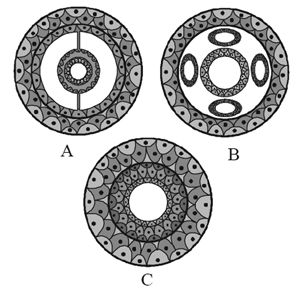
A. A - Pseudocoelomate; B - Coelomate, C-Acoelomate
B. A - Coelomate, B - Pseudocoelomate, C- Acoelomate
C. A - Coelomate; B- Acoelomate; C - Pseudocoelomate
D. A - Coelomate; B- Acoelomate; C-Eucoelomate
Answer : B

A. A - Pseudocoelomate; B - Coelomate, C-Acoelomate
B. A - Coelomate, B - Pseudocoelomate, C- Acoelomate
C. A - Coelomate; B- Acoelomate; C - Pseudocoelomate
D. A - Coelomate; B- Acoelomate; C-Eucoelomate
Answer : B
4. Which of the following is a correct match of a phylum with their three examples?
A. PlatyhelminthesPlanaria, Schistosoma, Enterobius
B. Mollusca Loligo, Sepia, Octopus
C. Porifera Spongilla, Euplectella, Pennatula
D. Cnidaria Bonellia, Physalia, Aurelia
Answer : B
A. PlatyhelminthesPlanaria, Schistosoma, Enterobius
B. Mollusca Loligo, Sepia, Octopus
C. Porifera Spongilla, Euplectella, Pennatula
D. Cnidaria Bonellia, Physalia, Aurelia
Answer : B
5. Heart is three - chambered in reptiles, except
A. turtle
B. Chameleon
C. Naja (Cobra)
D. crocodile
Answer : D
A. turtle
B. Chameleon
C. Naja (Cobra)
D. crocodile
Answer : D
6. Match the organisms given in column-I with their common name given in column-II and choose the correct option.
A. A II; C III; D I; E IV
B. A II; C IV; D I; E III
C. A II; C I; D III; E IV
D. A II; C I; D III; E IV
Answer : C
| Column -I | Column -II |
|---|---|
| (Organisms) | (Comman name) |
| A. Pennatula | I. Sea-lily |
| B. Antedon | II. Sea- pen |
| C. Echinus | III. Sea-urchin |
| D. Cucumaria | IV. Sea - cucumber |
A. A II; C III; D I; E IV
B. A II; C IV; D I; E III
C. A II; C I; D III; E IV
D. A II; C I; D III; E IV
Answer : C
7. Which of the following animal's body is covered by calcareous shell and unsegmented with a distinct head, muscular foot, and visceral hump?
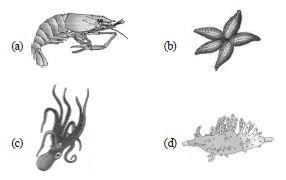
A. Click to check answer
B. Click to check answer
C. Click to check answer
D. Click to check answer
Answer : C

A. Click to check answer
B. Click to check answer
C. Click to check answer
D. Click to check answer
Answer : C
8. Animals like annelids, arthropods, etc. where the body can be divided into identical left and right halves in only one plane, exhibit___________symmetry.
A. radial
B. bilateral
C. asymmetrical
D. non- symmetrical
Answer : A
A. radial
B. bilateral
C. asymmetrical
D. non- symmetrical
Answer : A
9. Which of the following statement(s) is/are correct regarding phylum mollusca?
A. They are bilaterally symmetrical, triploblastic and coelomate animals.
B. Body is covered by a calcareous shell and is unsegmented with a distinct head, muscular foot and visceral hump.
C. The mouth contains a file-like rasping organ for feeding, called radula.
D. All of the above
Answer : D
A. They are bilaterally symmetrical, triploblastic and coelomate animals.
B. Body is covered by a calcareous shell and is unsegmented with a distinct head, muscular foot and visceral hump.
C. The mouth contains a file-like rasping organ for feeding, called radula.
D. All of the above
Answer : D
10. Which of the following traits is not shared by both sea anemones and jellyfish ?
A. A medusa as the dominant stage in the life cycle.
B. Possession of a gastro vascular cavity.
C. Sexual reproduction.
D. Nematocysts present on the tentacles.
Answer : A
A. A medusa as the dominant stage in the life cycle.
B. Possession of a gastro vascular cavity.
C. Sexual reproduction.
D. Nematocysts present on the tentacles.
Answer : A
11. Refer the following statement and answer the question. 'Name of X is derived from stinging capsules. It exhibits metagenesis containing two body forms in which sessile and cylindrical form is called Y and umbrella shaped and free swimming is called Z. Identify X, Y, and Z.
A. X - Coelenterate, Y - Polyp, Z - Medusa
B. X - Cnidarian, Y - Medusa, Z - Polyp
C. X - Ctenophora, Y - Radula, Z - Hypostome
D. X - Porifera, Y - Osculum, Z - Radula
Answer : A
A. X - Coelenterate, Y - Polyp, Z - Medusa
B. X - Cnidarian, Y - Medusa, Z - Polyp
C. X - Ctenophora, Y - Radula, Z - Hypostome
D. X - Porifera, Y - Osculum, Z - Radula
Answer : A
12. Column I contains zoological names of animals and column II contains their common name. Match the following and choose the correct option.
A. A III; B II; C I; D IV
B. A IV; B III; C II; D I
C. A IV; B II; C III; D I
D. A II; B III; C I; D IV
Answer : C
| Column -I | Column- II |
|---|---|
| A. Physalia | I. Sea anemone |
| B. Meandrina | II. Brain coral |
| C. Gorgonia | III. Sea fan |
| D. Adamsia | IV. Portuguese man-of-war |
A. A III; B II; C I; D IV
B. A IV; B III; C II; D I
C. A IV; B II; C III; D I
D. A II; B III; C I; D IV
Answer : C
13. The given figures A, B, C and D are the examples of first true land vertebrates. They are dominant in mesozoic era and belong to phylum ‘X’. Identify ‘X’ and the animals which have four chambered heart.
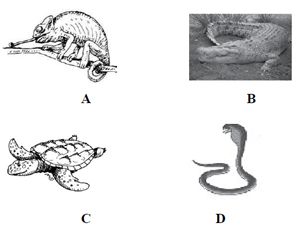
A. X – Reptile; B
B. X – Reptile; A
C. X – Amphibia, C
D. X – Pisces; D
Answer : A

A. X – Reptile; B
B. X – Reptile; A
C. X – Amphibia, C
D. X – Pisces; D
Answer : A
14. Which of the following sets of animals give birth to young ones?
A. Platypus, Penguin, Bat, Hippopotamus.
B. Shrew, Bat, Cat, Kiwi.
C. Kangaroo, Hedgehog, Dolphin, Loris.
D. Lion, Bat, Whale, Ostrich.
Answer : C
A. Platypus, Penguin, Bat, Hippopotamus.
B. Shrew, Bat, Cat, Kiwi.
C. Kangaroo, Hedgehog, Dolphin, Loris.
D. Lion, Bat, Whale, Ostrich.
Answer : C
15. A student brought home a strange animal which he found outside under a rock. It had moist skin, a complete digestive tract, a ventral nerve cord, and had gone through torsion. Identify the phylum of the animal.
A. Porifera
B. Annelid
C. Mollusca
D. Echinodermata
Answer : B
A. Porifera
B. Annelid
C. Mollusca
D. Echinodermata
Answer : B
16. Read the following statements and answer the question.
(i) They are exclusively marine, radially symmetrical, diploblastic organisms with tissue level of organisation.
(ii) Body bears eight external rows of ciliated comb plates, which help in locomotion.
(iii) Digestion is both extracellular and intracellular.
(iv) Reproduction takes place only by sexual means.
Which of the following phylum is being described by above statements?
A. Platyhelminthes
B. Arthropoda
C. Mollusca
D. Ctenophora
Answer : D
(i) They are exclusively marine, radially symmetrical, diploblastic organisms with tissue level of organisation.
(ii) Body bears eight external rows of ciliated comb plates, which help in locomotion.
(iii) Digestion is both extracellular and intracellular.
(iv) Reproduction takes place only by sexual means.
Which of the following phylum is being described by above statements?
A. Platyhelminthes
B. Arthropoda
C. Mollusca
D. Ctenophora
Answer : D
17. The given figures of animals (A & B) are distinguished on the basis of symmetry. Select the correct option which shows the type of symmetry and its description against the animals.
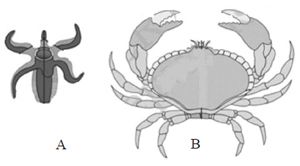
A. A : Biradial, organisms is divided into unequal halves by any plane through the central axis.
B. B: Bilateral, body is divided into equivalent right and left halves by only one plane.
C. A: Asymmetrical, organisms is not divided into equal halves by any plane through the central axis.
D. B: Radial, in which any plane passing through the central axis of the body divides the organism into two identical halves.
Answer : B

A. A : Biradial, organisms is divided into unequal halves by any plane through the central axis.
B. B: Bilateral, body is divided into equivalent right and left halves by only one plane.
C. A: Asymmetrical, organisms is not divided into equal halves by any plane through the central axis.
D. B: Radial, in which any plane passing through the central axis of the body divides the organism into two identical halves.
Answer : B
18. Match the terms/feature given in column I with their examples given in column II and select the correct match from the option given below.
A. A - i, B - ii, C - iii, D - iv, E - v
B. A - iii, B - v, C - ii, D - iv, E - i
C. A - iii, B - i, C - v, D - ii, E - iv
D. A - v, B - iv, C - iii, D - i, E - ii
Answer : D
| Column-I | Column-II |
|---|---|
| (Term/Feature) | (Examples) |
| A. Gregarious pest | i. Hirudinaria |
| B. Vector | ii. Planaria |
| C. Oviparous with | iii. Sepia indirect development |
| D. Metameres | iv. Aedes |
| E. High regeneration | v. Locust capacity |
A. A - i, B - ii, C - iii, D - iv, E - v
B. A - iii, B - v, C - ii, D - iv, E - i
C. A - iii, B - i, C - v, D - ii, E - iv
D. A - v, B - iv, C - iii, D - i, E - ii
Answer : D
19. Match the features given in column I with their examples given in column II and choose the correct match from the option given below.
A. A - e, B - b, C - d, D - c, E - a
B. A - c, B - a, C - d, D - b, E - e
C. A - b, B - a, C - c, D - e, E - d
D. A - c, B - b, C - d, D - a, E - e
Answer : B
| Column-I | Column-II |
|---|---|
| (Features) | (Examples) |
| A. Pseudocoelomates | a. Hydra, Adamsia |
| B. Diploblastic | b. Ctenoplana, Aurelia |
| C. Cellular level of | c. Ascaris, Wuchereria organization |
| D. Radial symmetry | d. Sycon, Spongilla |
| E. Metamerism | e. Pheretima, Neries |
A. A - e, B - b, C - d, D - c, E - a
B. A - c, B - a, C - d, D - b, E - e
C. A - b, B - a, C - c, D - e, E - d
D. A - c, B - b, C - d, D - a, E - e
Answer : B
20. Meandrina (brain coral) belongs to phylum
A. porifera
B. coelenterata
C. ctenophora
D. platyhelminthes
Answer : B
A. porifera
B. coelenterata
C. ctenophora
D. platyhelminthes
Answer : B
21. Which of the following group of animals belongs to the same phylum?
A. Earthworm, pinworm, tapeworm
B. Prawn, scorpion, Locusta
C. Sponge, Sea anemone, starfish
D. Malarial parasite, Amoeba, mosquito
Answer : B
A. Earthworm, pinworm, tapeworm
B. Prawn, scorpion, Locusta
C. Sponge, Sea anemone, starfish
D. Malarial parasite, Amoeba, mosquito
Answer : B
22. Which of the following is a living fossil?
A. Balanoglossus
B. Echinus
C. Ancylostoma
D. Limulus
Answer : D
A. Balanoglossus
B. Echinus
C. Ancylostoma
D. Limulus
Answer : D
23. Which of the following statements (i v) are incorrect?
(i) Parapodia are lateral appendages in arthropods used for swimming.
(ii) Radula in molluscs are structures involved in excretion.
(iii) Aschelminthes are dioecious.
(iv) Echinoderm adults show radial symmetry.
(v) Ctenophorans are diploblastic.
A. (i) and (ii)
B. (i) and (iii)
C. (i), (iv) and (v)
D. (iii) and (v)
Answer : A
(i) Parapodia are lateral appendages in arthropods used for swimming.
(ii) Radula in molluscs are structures involved in excretion.
(iii) Aschelminthes are dioecious.
(iv) Echinoderm adults show radial symmetry.
(v) Ctenophorans are diploblastic.
A. (i) and (ii)
B. (i) and (iii)
C. (i), (iv) and (v)
D. (iii) and (v)
Answer : A
24. Which of the follwoing statement(s) is/are correct?
(i) Organ systems in different group of animals show various patterns of complexities.
(ii) The digestive system in platyhelminthes has only a single opening to the outside of the body that serve as both mouth and anus, and is hence called complete.
(iii) In open type of circulatory system, the blood is pumped out of the heart and the cells and tissues are directly bathed in it.
(iv) In closed type, the blood is circulated through a series of vessels of varying diameters (arteries, veins and capillaries).
A. Only (i)
B. Both (ii) and (iii)
C. (i), (iii) and (iv)
D. All of these
Answer : C
(i) Organ systems in different group of animals show various patterns of complexities.
(ii) The digestive system in platyhelminthes has only a single opening to the outside of the body that serve as both mouth and anus, and is hence called complete.
(iii) In open type of circulatory system, the blood is pumped out of the heart and the cells and tissues are directly bathed in it.
(iv) In closed type, the blood is circulated through a series of vessels of varying diameters (arteries, veins and capillaries).
A. Only (i)
B. Both (ii) and (iii)
C. (i), (iii) and (iv)
D. All of these
Answer : C
25. The given figure shows some characteristic features marked as chordates. Identify the correct labelling A,B,C and D.
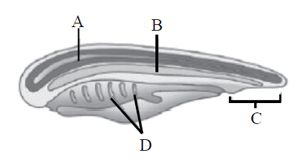
A. A-Notochord; B-Post-anal part; C-Gill slits; D-Nerve cord
B. A-Nerve cord; B-Notochord; C-Post-anal part; D-Gill slits
C. A-Notochord; B-Nerve cord; C-Gill slits; D-Post-anal part
D. A-Gill slits; B-Post-anal part; C-Nerve cord; D-Notochord
Answer : B

A. A-Notochord; B-Post-anal part; C-Gill slits; D-Nerve cord
B. A-Nerve cord; B-Notochord; C-Post-anal part; D-Gill slits
C. A-Notochord; B-Nerve cord; C-Gill slits; D-Post-anal part
D. A-Gill slits; B-Post-anal part; C-Nerve cord; D-Notochord
Answer : B
26. Which one of the following groups of animals is correctly matched with its characteristic feature without even a single exception ?
A. Reptilia : possess 3 - chambered heart with one incompletely divided ventricle.
B. Chordata : Possess a mouth provided with an upper and lower jaw.
C. Chondrichthyes : Possess cartilaginous endoskeleton.
D. Mammalia : Give birth to young one.
Answer : C
A. Reptilia : possess 3 - chambered heart with one incompletely divided ventricle.
B. Chordata : Possess a mouth provided with an upper and lower jaw.
C. Chondrichthyes : Possess cartilaginous endoskeleton.
D. Mammalia : Give birth to young one.
Answer : C
27. Which of the following is a connecting link between invertebrates and non-invertebrates?
A. Sphenodon
B. Balanoglossus
C. Tadpole larva
D. Crocodile
Answer : B
A. Sphenodon
B. Balanoglossus
C. Tadpole larva
D. Crocodile
Answer : B
28. Which of the following is a poisonous snake?
A. Naja (Cobra)
B. Bangarus (Krait)
C. Viper (Viper)
D. All of these
Answer : D
A. Naja (Cobra)
B. Bangarus (Krait)
C. Viper (Viper)
D. All of these
Answer : D
29. Which of the following characteristics is correct for reptilia?
A. Body covered with dry and cornified skin, scales over the body are epidermal, they do not have external ears.
B. Body is covered with moist skin an is devoid of scales, the ear is represented by a tympanum, alimentary canal, urinary and reproductive tracts open into a common cloaca.
C. Fresh water animals with bony endoskeleton and airbladder regulate buoyancy.
D. Marine animals with cartilaginous endoskeleton and body is covered with placoid scales.
Answer : A
A. Body covered with dry and cornified skin, scales over the body are epidermal, they do not have external ears.
B. Body is covered with moist skin an is devoid of scales, the ear is represented by a tympanum, alimentary canal, urinary and reproductive tracts open into a common cloaca.
C. Fresh water animals with bony endoskeleton and airbladder regulate buoyancy.
D. Marine animals with cartilaginous endoskeleton and body is covered with placoid scales.
Answer : A
30. Match the types of animals given in column I with their examples given in column II and choose the correct option.
A. A II; B V; C IV; D I; E III
B. A V; B II; C IV; D I; E III
C. A V; B II; C I; D IV; E III
D. A V; B IV; C II; D I; E III
Answer : B
| Column -I | Column -II |
|---|---|
| (Types of animals) | (Examples) |
| A. Limbless reptiles | I. Elephant |
| B. Jawless vertebrates | II. Lamprey |
| C. Flightless bird | III. Ichthyophis |
| D. Largest | IV. Ostrich terrestrial animal |
| E. Limbless amphibia | V. Cobra |
A. A II; B V; C IV; D I; E III
B. A V; B II; C IV; D I; E III
C. A V; B II; C I; D IV; E III
D. A V; B IV; C II; D I; E III
Answer : B
31. Which of the following phylum is being described by the given statements?
(i) These are primitive multicellular animals and have cellular level of organization.
(ii) Digestion is intracellular.
(iii) They have a water transport or canal system.
(iv) They reproduce asexually by fragmentation and sexually by formation of gametes.
A. Porifera
B. Ctenophora
C. Coelenterata
D. Platyhelminthes
Answer : A
(i) These are primitive multicellular animals and have cellular level of organization.
(ii) Digestion is intracellular.
(iii) They have a water transport or canal system.
(iv) They reproduce asexually by fragmentation and sexually by formation of gametes.
A. Porifera
B. Ctenophora
C. Coelenterata
D. Platyhelminthes
Answer : A
32. Column-I contains organisms and column-II contains their exeretory structures. Choose the correct match form the options given below.
A. A I; B III; C II; D IV; E V
B. A III; B I; C II; D V; E IV
C. A II; B I; C III; D V; E IV
D. A II; B III; C I; D V; E IV
Answer : D
| Column- I | Column -II |
|---|---|
| (Organism) | (Excretory structures) |
| A. Cockroach | I. Nephridia |
| B. Cat fish | II. Malpighian tubules |
| C. Earthworm | III. Kidneys |
| D. Balanoglossus | IV. Flame cells |
| E. Flatworm | V. Proboscis gland |
A. A I; B III; C II; D IV; E V
B. A III; B I; C II; D V; E IV
C. A II; B I; C III; D V; E IV
D. A II; B III; C I; D V; E IV
Answer : D
33. Which of the following statement is incorrect?
A. Platyhelminthes has incomplete digestive system.
B. In coelenterates, the arrangement of cells is more complex.
C. Nereis is monoecious but earthworms and leeches are dioecious.
D. Simple and compound eyes are present in the animals of those phylum whose over two-thirds of all named species on earth are arthropods.
Answer : C
A. Platyhelminthes has incomplete digestive system.
B. In coelenterates, the arrangement of cells is more complex.
C. Nereis is monoecious but earthworms and leeches are dioecious.
D. Simple and compound eyes are present in the animals of those phylum whose over two-thirds of all named species on earth are arthropods.
Answer : C
34. Match the phylum given in column - I with the special features present in them given in column - II and choose the correct option.
A. A III; B IV; C V; D II; E I
B. A IV; B III; C V; D II; E I
C. A III; B IV; C II; D V; E I
D. A III; B V; C IV; D II; E I
Answer : A
| Column -I | Column- II |
|---|---|
| (Phylum) | (Special features present) |
| A. Porifera | I. Mammary glands |
| B. Mollusca | II. Cloaca |
| C. Ctenophora | III. Choanocytes |
| D. Amphibia | IV. Radula |
| E. Mammalia | V. Comb plates |
A. A III; B IV; C V; D II; E I
B. A IV; B III; C V; D II; E I
C. A III; B IV; C II; D V; E I
D. A III; B V; C IV; D II; E I
Answer : A
35. In phylum arthropoda, excretion takes place through
A. nephridia
B. flame cells
C. malphigian tubules
D. gills
Answer : C
A. nephridia
B. flame cells
C. malphigian tubules
D. gills
Answer : C
36. Identify the figure with its correct name and phylum.
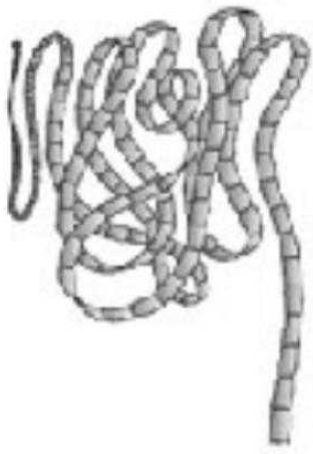
A. Sycon - Porifera
B. Aurelia - Coelenterata
C. Pleurobrachia - Ctenophora
D. Tapeworm - Platyhelminthes
Answer : D

A. Sycon - Porifera
B. Aurelia - Coelenterata
C. Pleurobrachia - Ctenophora
D. Tapeworm - Platyhelminthes
Answer : D
37. Which of the following characteristic distinguish arthropoda from annelids and molluscs ?
A. An external skeleton made of chitin (a polysaccharide) and protein rather than a shell made chiefly of mineral salts.
B. Subdivision of the legs into movable segments.
C. Distinct group of muscles, derived from many body segments, that move the separate parts of the exoskeleton.
D. All of the above
Answer : D
A. An external skeleton made of chitin (a polysaccharide) and protein rather than a shell made chiefly of mineral salts.
B. Subdivision of the legs into movable segments.
C. Distinct group of muscles, derived from many body segments, that move the separate parts of the exoskeleton.
D. All of the above
Answer : D
38. Which of the following pairs of animals comprises jawless fishes?
A. Mackerals and rohu
B. Lampreys and hag fishes
C. Guppies and hag fishes
D. Lampreys and eels
Answer : B
A. Mackerals and rohu
B. Lampreys and hag fishes
C. Guppies and hag fishes
D. Lampreys and eels
Answer : B
39. The given figures (A & B) shows the germinal layer. The animals having structures shown in the figures are respectively called

A. diploblastic, triploblastic
B. triploblastic, diploblastic
C. diploblastic, diploblastic
D. triploblastic, triploblastic
Answer : A

A. diploblastic, triploblastic
B. triploblastic, diploblastic
C. diploblastic, diploblastic
D. triploblastic, triploblastic
Answer : A
40. A student was given a specimen to identify on the basis of the characteristics given below.
(i) They are metamerically segmented.
(ii) Presence of closed circulatory system.
(iii) They have circular and longitudinal muscles for locomotion. Identify the specimen.
A. Prawn
B. Pheretima
C. Wuchereria
D. Ctenoplana
Answer : B
(i) They are metamerically segmented.
(ii) Presence of closed circulatory system.
(iii) They have circular and longitudinal muscles for locomotion. Identify the specimen.
A. Prawn
B. Pheretima
C. Wuchereria
D. Ctenoplana
Answer : B
41. Identify the animals shown in the given figures A, B and C from options given below.

A. A - Octopus; B -Asterias, C- Ophiura
B. A - Asterias; B - Ophiura, C- Octopus
C. A - Echinus; B - Octopus C - Ophiura
D. A - Ophiura; B - Echinus, C- Octopus
Answer : A

A. A - Octopus; B -Asterias, C- Ophiura
B. A - Asterias; B - Ophiura, C- Octopus
C. A - Echinus; B - Octopus C - Ophiura
D. A - Ophiura; B - Echinus, C- Octopus
Answer : A
42. Which of the following statement(s) is/are correct?
(i) Animals in which the cells are arranged in two embryonic layers, an external ectoderm and an internal endoderm, are called diploblastic animals.
(ii) Notochord is an ectodermally derived rod like structure formed on the ventral side during embryonic development in some animals.
(iii) In some animals, the body cavity is not lined by mesoderm, instead, the mesoderm is present as scattered pouches in between the ectoderm and endoderm and such a body cavity is called pseudocoelom.
A. Only (i)
B. Both (i) and (ii)
C. Both (i) and (iii)
D. All of these
Answer : C
(i) Animals in which the cells are arranged in two embryonic layers, an external ectoderm and an internal endoderm, are called diploblastic animals.
(ii) Notochord is an ectodermally derived rod like structure formed on the ventral side during embryonic development in some animals.
(iii) In some animals, the body cavity is not lined by mesoderm, instead, the mesoderm is present as scattered pouches in between the ectoderm and endoderm and such a body cavity is called pseudocoelom.
A. Only (i)
B. Both (i) and (ii)
C. Both (i) and (iii)
D. All of these
Answer : C
43. Few cnidarians like corals have a skeleton composed of
A. calcium hydroxide
B. calcium sulphate
C. calcium carbonate
D. sodium bicarbonate
Answer : C
A. calcium hydroxide
B. calcium sulphate
C. calcium carbonate
D. sodium bicarbonate
Answer : C
44. Refer the types of cells present in some animals. Each cell is specialized to perform a single specific function except
A. Cnidocytes
B. Choanocytes
C. Interstitial cells
D. Gastrodermal cells
Answer : C
A. Cnidocytes
B. Choanocytes
C. Interstitial cells
D. Gastrodermal cells
Answer : C
45. Refer the given figures A, B, C and D and identify the option which shows their correct name.
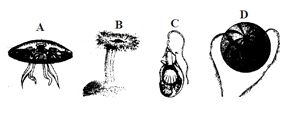
A. A - Pleurobrachia, B - Cnidoblast, C - Aurelia, D - Adamsia
B. A - Aurelia, B - Adamsia, C - Cnidoblast, D - Pleurobrachia
C. A - Cnidoblast, B - Pleurobrachia, C - Adamsia, D - Aurelia
D. A - Adamsia, B - Aurelia, C - Pleurobrachia, D - Cnidoblast
Answer : B

A. A - Pleurobrachia, B - Cnidoblast, C - Aurelia, D - Adamsia
B. A - Aurelia, B - Adamsia, C - Cnidoblast, D - Pleurobrachia
C. A - Cnidoblast, B - Pleurobrachia, C - Adamsia, D - Aurelia
D. A - Adamsia, B - Aurelia, C - Pleurobrachia, D - Cnidoblast
Answer : B
46. Identify the figure with its correct name and phylum.

A. Cucumaria – Echinodermata
B. Ascidia – Urochordata
C. Balanoglossus – Hemichordata
D. Hirudinaria – Annelida
Answer : C

A. Cucumaria – Echinodermata
B. Ascidia – Urochordata
C. Balanoglossus – Hemichordata
D. Hirudinaria – Annelida
Answer : C
47. Which of the following statements is incorrect ?
A. Prawn has two pairs of antennae.
B. Nematocysts are characteristic feature of the phylum cnidaria.
C. Millipedes have two pairs of appendages in each segment of the body.
D. Animals that belong to phylum porifera are exclusively marine.
Answer : D
A. Prawn has two pairs of antennae.
B. Nematocysts are characteristic feature of the phylum cnidaria.
C. Millipedes have two pairs of appendages in each segment of the body.
D. Animals that belong to phylum porifera are exclusively marine.
Answer : D
48. Which of the following features distinguish mammals from other vertebrates ?
A. Hairy skin and oviparity
B. Hairy skin and mammary glands
C. Mammary glands and teeth
D. Pinna and teeth
Answer : B
A. Hairy skin and oviparity
B. Hairy skin and mammary glands
C. Mammary glands and teeth
D. Pinna and teeth
Answer : B
49. Flame cells present in platyhelminthes, are specialized in
A. respiration and absorption.
B. osmoregulation and circulation.
C. respiration and excretion.
D. osmoregulation and excretion.
Answer : D
A. respiration and absorption.
B. osmoregulation and circulation.
C. respiration and excretion.
D. osmoregulation and excretion.
Answer : D
50. Refer the figures A, B, C and D given below. Which of the following options shows the correct name of the animals shown by the figures A, B, C and D ?

A. A – Locust, B – Scorpion, C – Prawn, D – Pila
B. A – Locust, B – Prawn, C – Scorpion, D – Pila
C. A – Locust, B – Scorpion, C – Prawn, D – Snail
D. A – Butterfly, B – Scorpion, C – Prawn, D – Pila
Answer : A

A. A – Locust, B – Scorpion, C – Prawn, D – Pila
B. A – Locust, B – Prawn, C – Scorpion, D – Pila
C. A – Locust, B – Scorpion, C – Prawn, D – Snail
D. A – Butterfly, B – Scorpion, C – Prawn, D – Pila
Answer : A
Sharing is caring
Related Post
LIC AAO - Windows 2000 Server 1000+ MCQ [Solved] PDF Download
1000+ Urinary Calculus Disease MCQ for RRB ALP [Solved]
SSC JHT - General knowledge 1000+ MCQ [Solved] PDF Download
1000+ Choosing the correct sentence Multiple Choice Question Answer [Solved]
Classifications of Animal Kindom MCQ Solved Paper for ISRO Recruitment
1000+ Urologic infections and inflammations Multiple Choice Question Answer [Solved]